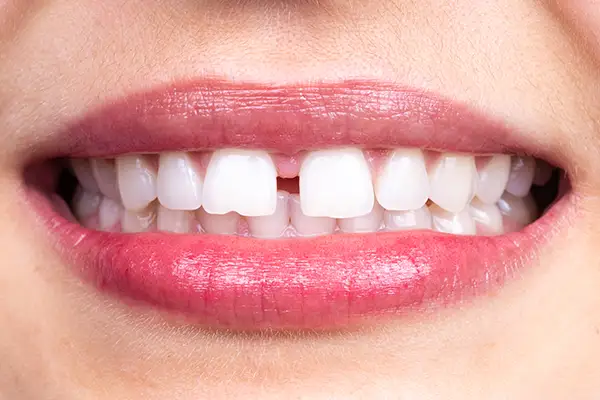Top 3 Options for Fixing Gaps in Your Teeth
Posted on 6/16/2025 by Riverwind Dental |
 Do you have gaps in your teeth? If so, you're not alone. Gaps, also known as diastema, are quite common and can occur between any two teeth. While some people find gaps to be charming, others are self-conscious about them and wish to close them up. Do you have gaps in your teeth? If so, you're not alone. Gaps, also known as diastema, are quite common and can occur between any two teeth. While some people find gaps to be charming, others are self-conscious about them and wish to close them up.
The good news is that there are several options available for fixing gaps in your teeth. In this post, we'll discuss the top three options and help you understand how each one works, its pros and cons, and its suitability for different situations. Remember, consulting with an expert general dentist is essential to determine the best approach for your specific needs.
1. Dental Bonding: A Simple and Affordable Solution
Dental bonding is a relatively simple and affordable procedure that can be completed in just one office visit. During the procedure, a tooth-colored composite material is applied to the tooth surface and sculpted to fill in the gap. Once the composite is shaped and hardened with a curing light, it is polished to match the surrounding teeth.
Pros of dental bonding:
| • |
Affordable: Compared to other options, dental bonding is the most cost-effective method for closing gaps. |
| • |
Conservative: Bonding requires minimal preparation of the tooth surface, making it a conservative option. |
| • |
Fast: The procedure can be completed in a single appointment. |
Cons of dental bonding:
| • |
Less durable: Bonding is less durable than other options and may need to be replaced after a few years. |
| • |
Susceptible to staining: Bonding material can stain over time, especially with smoking or consumption of dark-colored food and drinks. |
Suitability: Bonding is a suitable option for small gaps and patients who are looking for a quick and affordable solution.
2. Veneers: A Natural-Looking and Long-lasting Option
Veneers are thin, custom-made shells that are placed over the front surfaces of your teeth. They are made of porcelain or composite material and are designed to look and feel like natural teeth. To prepare for veneers, a small amount of tooth enamel is removed to create space for the veneer. The veneers are then permanently bonded to the teeth.
Pros of veneers:
| • |
Natural Appearance: Veneers can create a beautiful, natural-looking smile. |
| • |
Durable: Veneers are more durable than bonding and can last for many years with proper care. |
| • |
Stain-resistant: Porcelain veneers are resistant to staining. |
Cons of veneers:
| • |
More expensive: Veneers are more expensive than dental bonding. |
| • |
Irreversible: Preparing teeth for veneers involves removing enamel, which is an irreversible process. |
| • |
May require additional procedures: In some cases, additional procedures such as root canals may be needed before getting veneers. |
Suitability: Veneers are an excellent option for individuals with larger gaps or those looking for a long-lasting, natural-looking solution.
3. Braces or Invisalign: Addressing the Underlying Cause
Braces and Invisalign are orthodontic treatments that can address the underlying cause of gapped teeth – misaligned teeth and jaws. Braces use metal brackets and wires to gradually move teeth into the desired positions, while Invisalign uses a series of clear, removable aligners to achieve the same result.
Pros of braces and Invisalign:
| • |
Treat the underlying cause: Braces and Invisalign address the root cause of gapped teeth, not just the gaps themselves. |
| • |
Long-lasting results: With proper care, the results of orthodontic treatment can last a lifetime. |
| • |
Improve oral health: Straightening teeth can improve your oral health by making it easier to clean your teeth and reducing your risk of gum disease. |
Cons of braces and Invisalign:
| • |
Treatment time: Treatment with braces or Invisalign typically takes several months or years. |
| • |
Discomfort: Braces can be uncomfortable, especially during the initial adjustment period. |
| • |
Cost: Braces and Invisalign are the most expensive option for closing gaps in teeth. |
Suitability: Braces and Invisalign are suitable for individuals with significant gaps or those with underlying orthodontic issues.
Conclusion
Ultimately, the best option for fixing gaps in your teeth depends on your individual needs and preferences. Consult with your general dentist to discuss your options and determine the best course of action for you. They will be able to assess your oral health, discuss the pros and cons of each option, and recommend the most suitable approach for achieving your desired smile. |
|